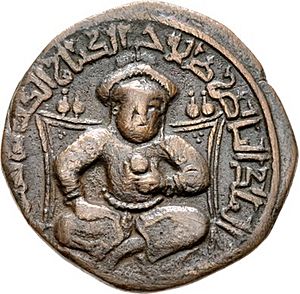Ayyubid dynasty facts for kids
The Ayyubid dynasty was a powerful Muslim family that came from a region called Kurdistan. They ruled a large area in the Middle East during the 12th and 13th centuries. Their empire included places like Egypt, Syria, Yemen, and parts of Iraq. This dynasty is also sometimes called the Ayoubites or Ayyoubides.
The Ayyubid dynasty was started by a famous leader named Saladin. Saladin and his uncle, Shirkuh, took control of Egypt in 1169. They did this for the Zengid King Nur ad-Din of Damascus. The dynasty got its name from Saladin's father, Najm ad-Din Ayyub.
Contents
Who Were the Ayyubids?
The Ayyubids were a family of Kurdish origin. They became very important in the Middle East after Saladin rose to power. They were known for their strong armies and for building many important structures. These included schools, hospitals, and fortresses.
Saladin: The Founder
Saladin is the most famous member of the Ayyubid family. His full name was Salah ad-Din Yusuf ibn Ayyub. He was a brilliant military leader and a wise ruler. Saladin is especially known for uniting many Muslim lands. He also led the fight against the Crusaders during the 12th century.
How Saladin Rose to Power
Saladin first went to Egypt with his uncle Shirkuh. They were sent by Nur ad-Din, the Zengid ruler of Damascus. Their mission was to help the Fatimid rulers of Egypt. After Shirkuh died, Saladin became the vizier, or chief minister, of Egypt. He slowly gained more power and eventually took full control.
Saladin's Great Victories
Saladin's most famous victory was at the Battle of Hattin in 1187. In this battle, his army defeated a large Crusader force. This victory allowed him to recapture Jerusalem from the Crusaders. This was a very important event for the Muslim world.
Where Did the Ayyubids Rule?
The Ayyubid Empire was very large at its peak. It stretched across many important regions in the Middle East and North Africa.
Major Ayyubid Territories
- Egypt: This was the heart of the Ayyubid Empire. Its capital, Cairo, became a major center of learning and trade.
- Syria: Important cities like Damascus and Aleppo were under Ayyubid control. These cities were key for trade routes.
- Yemen: The Ayyubids also ruled most of Yemen, a region known for its trade and coffee.
- Other Areas: They also controlled parts of northern Iraq, Mecca, and the Hejaz region (which includes Mecca and Medina).
Building an Empire
The Ayyubids built many strong fortresses and walls to protect their lands. They also encouraged trade and learning. Many schools (called madrasas) and hospitals were built during their rule. This helped their cities grow and become prosperous.
The End of the Ayyubid Dynasty
The Ayyubid dynasty lasted for about 80 years. After Saladin died in 1193, his sons and relatives often fought among themselves. This weakened the empire over time.
Challenges and Decline
The Ayyubids faced challenges from inside and outside their empire. They had to deal with new Crusader attacks. They also had to manage internal conflicts between different Ayyubid princes.
Rise of the Mamluks
In Egypt, the Ayyubids relied on a group of slave soldiers called the Mamluks. Over time, the Mamluks became very powerful. In 1250, the Mamluks took control of Egypt from the Ayyubids. They then formed their own dynasty. The Ayyubids continued to rule in some parts of Syria for a few more decades. However, their main power was gone.
Legacy of the Ayyubids
The Ayyubid dynasty left a lasting mark on the Middle East. They are remembered for their strong leadership, especially Saladin's. They also contributed to the region's culture and architecture.
Architecture and Learning
The Ayyubids built many impressive buildings. These included mosques, madrasas (religious schools), and citadels. The Cairo Citadel in Egypt is a famous example. They also supported scholars and scientists, which led to advancements in different fields.
Cultural Impact
The Ayyubid period was a time of cultural growth. They helped spread Islamic learning and art. Their rule helped shape the history and identity of many countries in the Middle East.
Images for kids
-
Sketch of the original "Eagle of Saladin" of the Cairo Citadel, Egypt.
-
The Kingdom of Jerusalem mostly fell to the Ayyubids after their victory against the Crusaders in the Battle of Hattin in 1187.
-
Al-Kamil (right) and Frederick II signed a treaty to return Jerusalem to the Crusaders for ten years.
-
The Firdaws Madrasa was built in 1236 in Aleppo.
See also
 In Spanish: Dinastía ayubí para niños
In Spanish: Dinastía ayubí para niños











